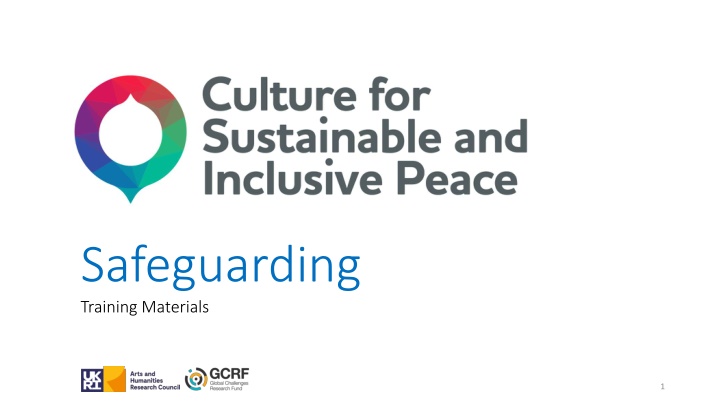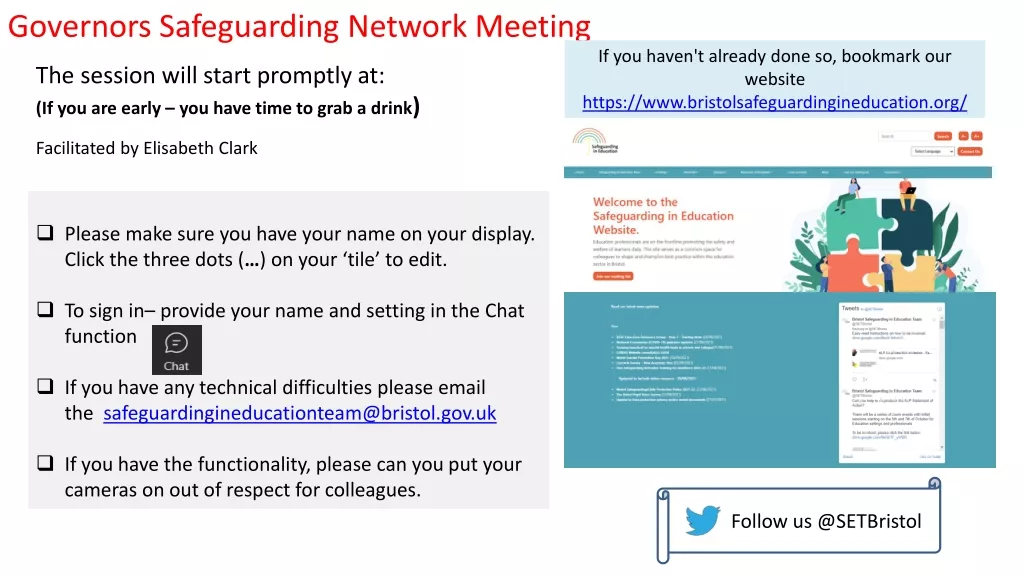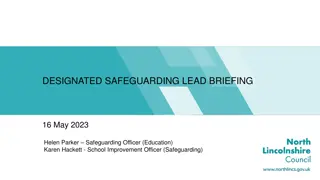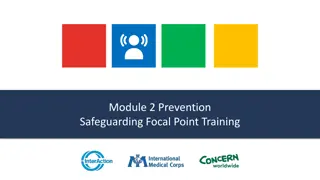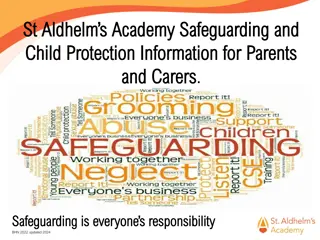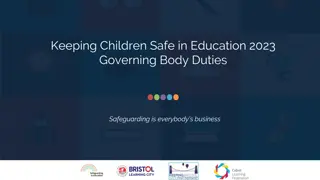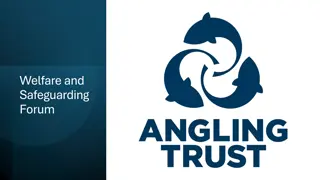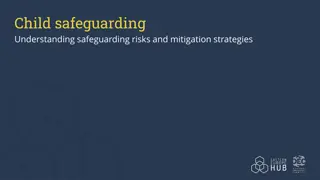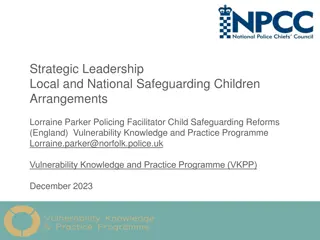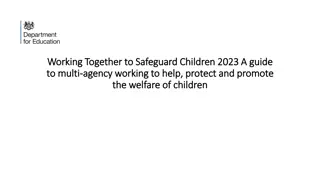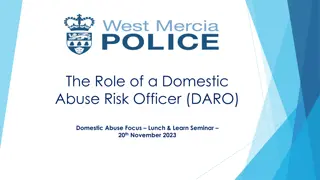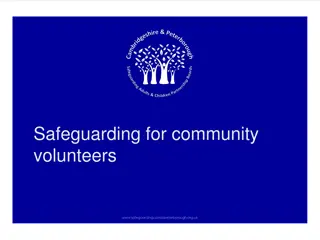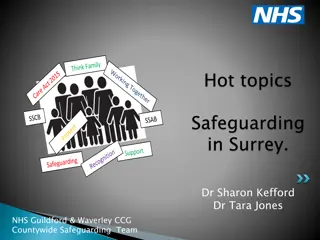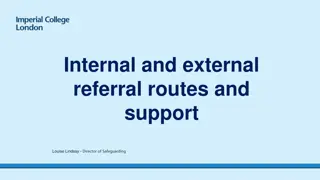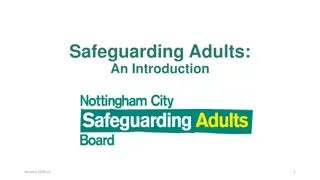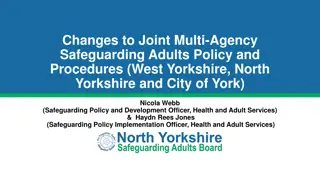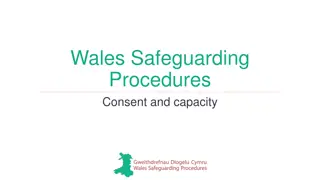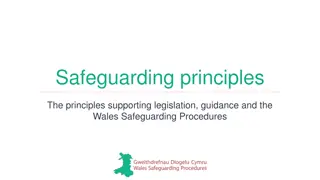Safeguarding
This overview covers the importance of safeguarding, key principles, and the shared responsibility among CUSP partners to ensure a safe environment. It emphasizes the need for proactive measures and a systematic approach to prevent harm in international development contexts.
Download Presentation

Please find below an Image/Link to download the presentation.
The content on the website is provided AS IS for your information and personal use only. It may not be sold, licensed, or shared on other websites without obtaining consent from the author.If you encounter any issues during the download, it is possible that the publisher has removed the file from their server.
You are allowed to download the files provided on this website for personal or commercial use, subject to the condition that they are used lawfully. All files are the property of their respective owners.
The content on the website is provided AS IS for your information and personal use only. It may not be sold, licensed, or shared on other websites without obtaining consent from the author.
E N D
Presentation Transcript
Safeguarding Training Materials 1
Content Unit 1: The Why and What - CUSP s Safeguarding Principles and Code of Conduct Unit 2: The How - Reporting and responding Unit 3: The Where - Contextualising Safeguarding Measures
How to use these slides Please note: these slides aim to support your training on Safeguarding. Please refer to the Safeguarding policy document for a more detailed and comprehensive discussion of Safeguarding. Please feel free to adapt these slides to your context and develop differentactivities that could be more relevant to you and your team. You can also use the slides for self-training, adapting the group discussions and activities and turning them into moments for your reflection.
Unit 1: Safeguarding Principles In Unit 1 you will explore our basic safeguarding principles, and our code of conduct.
Why do we need safeguarding? CUSP operates in Low- and Middle-Income countries, engaging with young people, women who have been abused, children, minority groups. Every person should live their lives without harm, either malicious or unintended. In our work, it is vital that every person is kept safe. Following instances of abuse of vulnerable people in international development contexts, UK law now requires every organisation to have safeguarding measures in place. Our Safeguarding Policy is intended to protect everyone who works on CUSP (and everyone who comes into contact with our programmes and/or staff) from any form of abuse and harm through a systematic approach.
What do we mean by safeguarding By Safeguarding we mean the process and procedures that, as a group of people working together in collaboration, we set in place to ensure that everyone in CUSP feels safe and respected at all times and that, should any harm happen despite our efforts, we are able to intervene to minimise harm and to respond promptly to any concerns. Safeguarding is a shared responsibility of all CUSP partners and should be approached in a spirit of inclusiveness and mutual learning. CUSP s Safeguarding Policy covers expectations regarding the conduct and behaviour of all CUSP staff and associated personnel including: the Principal Investigator (i.e. the main applicant and project lead), any Co-Investigators (i.e. Co-applicants); all researchers; any PhD students linked to the project; research assistants; administrators; advisors; third-party contractors; and staff of all partner organisations (i.e. academic institutions, non- governmental and community-based organisations). Safeguarding principles and rules apply irrespective of whether the work is undertaken on a full or part time basis, is temporary or permanent, paid or unpaid.
Abuse and harm can include: Physical abuse Sexual abuse Emotional abuse Bullying Neglect Financial (or material) abuse Abuse and harm can be inflicted directly or can be caused by the failure to act to protect an individual from others. For a definition of each type of abuse, please see our Safeguarding document.
CUSPs Safeguarding principles Everyone has a responsibility for safeguarding; Do no harm; Organisations have a safeguarding duty of care to everyone; Everyone shall act with integrity and compassion; Everyone shall be treated equally irrespective of age, race, gender, religion, sexual orientation or disability; and Everyone will ensure confidentiality at all stages of the safeguarding process.
U1 Activity In group(s), try to translate the Safeguarding principles in your local language(s). Discuss the following points Do all safeguarding principles translate easily? Which do you find difficult to translate? Why do you think this is? Please note, this activity will require some time, but it may be very useful for future work. Your group could make a poster or a word document which could be used any time you engage with a new staff member.
Our code of conduct Not to harm children, young people, vulnerable adults or anyone they come into contact with during the course of their engagement with CUSP N+, through action or omission; Not to expose others to the risk of discrimination, neglect, harm or abuse; Not to purchase, or coerce, sex acts; To work in accordance with health, safety and security guidelines and avoid behaviour that creates unnecessary risk to themselves or others; Not to engage in sexual activity with children under the age of 18; and Not to engage in sexual relationships with members of the community groups directly involved in the research As you read these rules, please take notes. What do these rules make you think? Do you have a unique code of conduct for your own profession? Does it list a series of specific Does and Don ts or is it more generic? What do you think about the fact that most of our rules start with NOT TO instead of TO.. ?
U1 Group discussion What are the differences between the Code of Conduct and Safeguarding Principles? Why do we need both? You can search the two terms online. Some professions in the UK, for example interpreters, need to adhere to the Code of Conduct of the agencies they work for. Different agencies have different Codes of Conduct. But it is different with Safeguarding Principles . You can compare different codes of conduct and safeguarding principles, here are a couple of links that you can use as a case study: CAPITA Translation and Interpreting Language Market Place UK
U1 Activity B If you wonder about Consent, this video explains Consent in a clear and fun way. Please, note that even if participants decide to take part in the research, they may want to withdraw at a later stage. Sometimes, even if they feel uncomfortable, they may not withdraw in order to avoid disappointing the researcher. Please, ensure that your participants do not feel under pressure, and ensure that you are attentive to participants needs.
U1 Individual reflection - Do you think that CUSP s safeguarding principles could be universal? - Why yes? Why not? - Was there anything that surprised you or that you did not expect? Were you already familiar with the notion of safeguarding ? Is there a specific word in your language for safeguarding ? - Are there any principles that you do not fully understand? If so, please, do contact your local Safeguarding Officer. Feel free to write your thoughts on these questions in your journal. You do not have to discuss the thoughts with anyone, unless you decide to. 13
Unit 2: Reporting and Responding In Unit 2 you will learn about our reporting and responding procedures.
Who to contact To discuss or report any concerns you may have regarding a breach of CUSP N+ s Code of Conduct or a specific safeguarding incident, you should contact: Your line manager . This isthe person who supervises your work,for example the lead researcher (Co-Investigator) of the work package in which you are involved. If you prefer you can approach the Local Safeguarding Officer to discuss any safeguarding concerns; to report a specific safeguarding concern or incident verbally or in writing. If you are reporting a specific concern or incident that involves someone else, you should report this within 24 hours. There is a Safeguarding Reporting Form (Annex E in the Safeguarding Policy document), but you are not obliged to use it. You can send the information in the body of an email if you prefer. You can also send a report to the dedicated Safeguarding Email Address: cusp- safeguarding@glasgow.ac.uk 15
The reporting process flowchart The flowchart to the left shows what to do if you think there has been a safeguarding incident. This can be: an immediate concern (something that has just happened) a potential concern (something that may happen) a historic concern (something that happened in the past) Make sure you familiarise yourself with who the local emergency contact and/or the local safeguarding officers are, so you can contact them in the first instance. They will evaluate if the issue needs further attention. PI = project main applicant (the person who leads the project Co-I = project co-applicant (in some projects there may not be a Co-I) 16
U2 Activity A Read the three scenarios below and discuss with others what you would do. Compare what you agreed with the answers we provide on the next page. Were your solutions similar/different? Scenario 1 You are visiting a children's acting workshop to conduct some interviews. You see a workshop leader strike a child (of around ten years old) for getting their lines wrong. The workshop leader makes the child stand in the centre of the group and berates them in front of the other children. Scenario 3 Scenario 2 You are touring a local community with your organisation's new project manager, Alex. Other staff have told you rumours that Alex has a criminal record and lied on their work application. Alex later tells you that they recorded a conversation between you and a community member during the tour for a fly-on-the-wall podcast clip. Your organisation's social media officer has published a series of tweets using clips from your fieldwork interviews with young people. One video is of a confidential interview where the young person discloses details of gender-based violence and the continuing impact it is having on their life. The post has been viewed and retweeted by several prominent individuals and organisations. As a result your organisation's website has had a large increase in site traffic and you've received offers of donations for your work. 17
U2 Activity A our answers This is how we think one should respond in the three different scenarios Scenario 1 This is an immediate safeguarding issue, and the safety and wellbeing of the child is of urgent concern. You take the workshop leader to one side and ask him/her to stop hitting and humiliating the child as this is against the child s rights, harmful to them and against your project s policy. Following this, you contact the local safeguarding officer and ask them follow this up with appropriate people (e.g. the acting group manager). Scenario 2 This is a safeguarding issue and data management breach, as the interview was confidential and for research purposes only. Even if this is beneficial to your organisation, the safety and confidentiality of each individual is the priority. You immediately contact the social media officer to delete the tweets and post an apology. Following this, you contact the local safeguarding officer and ask them follow this up with appropriate people within your organisation, including the data protection office, if you have one. You should review your data management plan to ensure data is kept secured and accessible only to those who are required to use it for permitted purposes. Scenario 3 This is an immediate safeguarding issue, as under no circumstances should people be recorded in any way without their consent. You ask Alex to delete the clip and any others recorded without permission. If you are satisfied that Alex now understands and will comply with confidentiality and consent processes, you may not need to escalate this further. You may still wish to alert the local safeguarding officer so the incident can be recorded. If Alex does not comply, you should report the incident to the local safeguarding officer. Rumours about Alex's criminal record or lying are inconsequential, and should not affect how you proceed. 18
U2 Activity B (and group discussion) In group(s), make up one safeguarding scenario (referring to immediate potential or historic incidents) likely to happen in your context, and the procedure you would expect colleagues to follow Swap the scenarios you have created and discuss them Do you all agree on the procedures to follow? If there are differences, please discuss these until you find consensus It would be great if you could send any scenarios you devise to the dedicated safeguarding email address
Safeguarding investigation and possible outcomes Once a safeguarding issue has been raised, there will be a safeguarding investigation. The investigation can have 3 outcomes The investigator finds that a safeguarding violation has occurred. Appropriate disciplinary action should be taken to remove the person from the project. The Local Safeguarding Officer will undertake a due diligence review of the partner institution / organisation to ensure that appropriate procedures have been followed. They will also carry out a risk assessment to determine any changes that should be made to the safeguarding policy. The funder will be notified of the incident, the outcome of the investigation and the actions that have been taken. The investigator finds that a safeguarding violation has not occurred. The Local Safeguarding Officer closes the report. Anonymous information on the type of concern/ incident, outcome and actions taken are added anonymously to the register. The Local Safeguarding Officer will undertake a due diligence review of the partner institution / organisation to ensure that appropriate procedures have been followed. They will also carry out a risk assessment to determine any changes should be made to the safeguarding policy. The funder will not be informed. The investigator decides there is insufficient evidence to proceed with an investigation (for example, the name of the person(s) affected by safeguarding incident or concern is/are unknown). In this case, the report and outcome are filed. Anonymous information on the type of concern/incident, outcome and actions taken are added anonymously to the register. The Local Safeguarding Officer will undertake a due diligence review of the partner institution / organisation to ensure that appropriate procedures have been followed. They will also carry out a risk assessment to determine any changes should be made to the safeguarding policy. The funder will not be informed. When a safeguarding report has been made, the PI (i.e. the project s main applicant) and/or the local safeguarding officer will ensure support mechanisms are in place for those affected by the safeguarding concern/incident. This will be irrespective of the possible outcome of the investigation. Decisions regarding the type of support should be led by the person(s) affected 20
U2 - Individual reflection What do you think you might find more difficult about reporting as safeguarding concern? How could you improve this? Who do you think you could go for help? Feel free to write your thoughts on these questions in your journal. You do not have to discuss the thoughts with anyone, unless you decide to. 21
Unit 3: Contextualising Safeguarding Measures In Unit 3 you will reflect on the importance of contextualising Safeguarding measures, and you will be prompted to think about your own context.
Why do we need to contextualise safeguarding? CUSP operates in different Low- and Middle-Income countries, engaging with different groups of people. We acknowledge that infrastructure to safeguarding are different in any context. As part of our overarching approach, we consider local knowledges at the heart of our work. Therefore, even though our safeguarding principles are the same across the different contexts in which we operate, we ask our partners to reflect on how these principles translate in practice in each context. We perceive safeguarding as a matter of collective ownership, and therefore we have local Safeguarding Officers that ensure that our Safeguarding measures are relevant and up-to-date. Local Safeguarding Officers co-create and update our Safeguarding measures. Meet our local Safeguarding Officers HERE.
U3 Activity A Watch the video that Ignite Theatre company made. In this film, a group of young people (15-22 years old) from the UK, Scotland, present different sketches on their lived experiences, and guided by questions such as: what makes you feel safe? What makes you feel valued? Please note, this activity aims to make you think about your own context. What would be important for your team and for the groups you work with? You can use the Learning Card to guide your discussion and reflections.
U3 Activity A Learning Card on Advice on Safeguarding Questions for reflection on the video: Activity Respecting the Boundaries: Which boundaries exist within your groups? Which boundaries need to exist so to ensure you work in a safe space? How could you make sure that you and your group respect the boundaries while at the same establish relations of trust with participants and co-workers? You could may use the following prompts to create and perform possible interactions and role-plays. Dividing the group into small groups, ach member could be assigned a role within a situation. Ask to improvise a sketch and all the group then reflects together on these situations. What would you do in your context if, for example, Respect How would you promote respect within your team, and with your participants? A teacher offers you a lift Someone in your care reports s/he has been harassed and discriminated Diversity & Inclusion How could you ensure in your group that diversity is respected and welcomed, and that people are not discriminated on the basis of race, gender (and gender identity), disabilities, religion, what they wear, sexuality what they own, how they talk? Someone in your care reports s/he has been bullied You suspect someone is abusing his/her power Exam Day Who can you report to if you are worried about the safety of your group members? Are all those involved aware of reporting mechanisms, in case a safeguarding principle is not respected?
Safeguarding and Research Methodology Safeguarding is about keeping people safe. In research, we consider it as part of research ethics. Depending on the research activities you will be conducting, there may be different ways of keeping your participants and your researchers safe, also depending on your own context. As part of CUSP, you will need to abide to our ethics guidance, that will be given to you at the start of the project. However, we remind you here that: Unless agreed differently, participants anonymity is to be kept secure Data must be stored securely You always need consent before starting any research activities Participants can withdraw at any point, without giving explanations. Respect participants silence, and make sure you do not, even unintentionally, put pressure on participants If you are to discuss difficult life experiences, ensure you are trained to do so and that you do not cause harm As a researcher, you may need help and support, especially if you are working on difficult topics. Ensure you are aware of the risks, and you know who you may contact for help.
U3 Group Discussion As we work mainly with practice-based, arts-based, and participatory methodologies, building trust with our participants is vital. How can we create a safe environment?
Researching in the time of covid-19: online safety Covid-19 has changed the way we do research. Due to lockdowns and strict restrictions, a lot of our research had to be moved online. As lots of our interactions are now online, increased risks include: Cyber-bullying Grooming Online abuses Sexting etc. Several organisations have developed guidelines to protect ourselves, our children and young people online. For example, have a look at the resources developed by the NSPCC. If you work with children and need to work online, Think You Know developed a series of animations, with related storybooks, for young children about online safety. You can access their resources here
Self-assessment & Feedback on our resources You can self-assess your understanding on safeguarding and research ethics using this quiz. If you are unsure about any questions and have doubts about your answers, please feel free to contact us at CUSP-info@glasgow.ac.uk . The quiz could also be used as a tool to test the understanding of safeguarding among your team. You can send us your feedback on our resources using this short, anonymous questionnaire . Your feedback will be very valuable to amend and update our resources on a regular basis.
